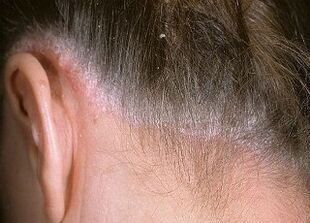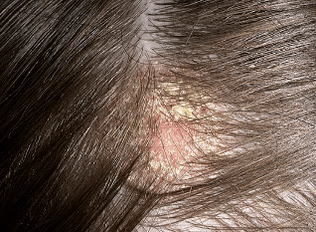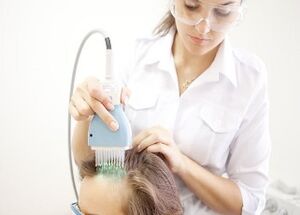
Psoriasis is a chronic disease of the upper layers of epidermal cells that is accompanied by dead skin cells. The most common disease is psoriasis on the head. The disease is accompanied by large or small formations in the scalp.
Very often the lesion is localized in one place. Late treatment can make the situation worse.
This type of disease is not passed on to others. A person suffering from such a disease is safe for society.
Factors in psoriasis development
The main cause of skin defects is a metabolic disorder.
As mentioned earlier, the disease is not contagious, so the patient cannot harm the health of those around him. The presence of psoriasis in a person indicates the inability of the body to respond normally to the presence of various types of stimuli. As a result, excessive cell division occurs. According to statistics, the normal process of cell division is about 30 days.
During this time, the upper layer of the epidermis is gradually replaced with new ones. In psoriasis, overgrowth of new cells can be seen that begin to overlap with old ones. The dividing period is reduced by 4 days. As a result, small scaly lesions appear on the surface of the scalp.
In most cases, they appear as a slight inflammation with itching. When peeling the old layer of epidermis, pink spots of various shapes are formed on the surface of the skin. Gradually they begin to be covered with new formations of skin cells.
Scientists have identified a number of reasons that can also cause a malfunction in normal metabolism, including:
- have bad habits. Excessive abuse of alcohol and tobacco products leads to significant changes throughout the body. With the presence of psoriasis on the head, the toxic substances that make up alcohol and cigarettes have a negative effect on the course of the disease.
- Wrong power supply. The patient's diet contains many products with a large amount of food additives and carcinogens. Bad eating can be the early stages of psoriasis.
- Mechanical damage to the hairline. Dandruff can occur with repeated injuries. The bacteria on the comb can invade the affected area of the scalp, triggering the disease mechanism.
- Problems of the gastrointestinal tract.
- Unstable temperature conditions. This problem occurs during the period of seasonal changes in weather conditions.
- long-term medication.
- Failure of the endocrine system.
- Genetic disposition of the organism.
If serious signs of psoriasis appear on the scalp, it is recommended that you contact a professional dermatologist. He will choose the appropriate treatment to prevent new lesions from appearing. Psoriasis on the scalp most often affects people between the ages of 30 and 36. It rarely occurs in young children
Symptoms
In the first stages of the course of psoriasis, the patient does not feel any changes. The disease progresses slowly and without symptoms. On visual examination, in rare cases, the doctor observes the presence of dandruff in insignificant amounts. With a more complex course of psoriasis of the scalp, the patient experiences severe itching and burning in the back of the head, forehead and ears. Plaques with dry scaly elements form on the affected areas.
Microcracks begin to form on the skin, through which the infection enters the body. At the point of the peeling, dry areas of skin begin to grow quickly. Under mechanical stress, these plaques begin to peel off and leave red spots behind. In this case, the patient must choose the appropriate drug to prevent the disease from progressing.
Main localization locations
Today, psoriasis on the head is a fairly common type of disease that occurs in every fourth patient. Early treatment is the number one reason the disease can spread throughout the body. The disease can take different forms, each with new health problems.

The main sites for psoriasis of the scalp are:
- Skin around the ears, the back of the head, behind the auricle;
- frontal lobe area, parietal area;
- posterior region of the cervical spine;
- Separation area of the hair growth.
The disease has two forms: mild and severe.
At the initial stage, the patient does not have any unpleasant sensations. The main symptom may be the persistent presence of dandruff that appears two days after you wash your hair. With a severe form of the disease, the patient has psycho-emotional discomfort, a constant burning sensation and itching in the affected area of the skin.
Psoriasis: classification and varieties
Psoriasis on the head has several stages in the course of the disease.
Dermatologists divide psoriasis of the scalp into the following stages:
- Initial.There are small pink papules that rise slightly above the skin. The patient may feel slight itching in the affected area. Mechanical action removes small fragments of dead skin cells.
- Progressive.The presence of new lesions is noted here. The patient begins to suffer from severe discomfort, which is accompanied by constant itching and profuse peeling. Papules gradually expand peripherally from one another.
- Stationary.At this stage, most of the scalp is affected by lesions. Old areas do not disappear, but, on the contrary, begin to move forward with greater force.
- regressive.Characterized by the presence of a large number of white circles in the affected area. The skin starts to dry a lot. A large number of scaly formations are present on the surface of the papules.
Severe disease can lead to the death of hair follicles, leading to premature baldness in certain areas of the head. Scaly patches gradually thicken due to dead skin cells. On visual inspection, bright growths are observed on the surface of the hairline. Men are exempt from military service, as moral and physical stress provokes severe disease.
Classification and varieties
In medicine there are two groups of psoriasis on the scalp. Each of them has a complex of varieties, which describes all the characteristic diseases that are accompanied by similar symptoms. This includes the pustular type.
It contains several groups:
- generalized form;
- palmoplantar;
- is ring-shaped.
A non-pustular type is again divided into:
- the traditional form of the disease;
- psoriasis.
Each type and subgroup has similar symptoms, but different rates of disease progression. With the pustular type of the disease, the patient has a progressive spread of foci that need good drug treatment. With a non-pustular type, the skin is less prone to attack by new formations.
The course of psoriasis in childhood
In young children, psoriasis of the scalp is often compared with an allergic reaction in the early stages - there is a slight reddening of the skin surface with peeling elements. In most cases, the affected area is compared to diaper rash, candidiasis, and eczema.
The disease runs in slow motion. Often, various drugs that contain aggressive components are the first trigger for the appearance of defects in the scalp. The child must be treated under the guidance of an experienced dermatologist.
The initial stage of therapy is a strict diet. Citrus fruits, all kinds of colorings, fatty foods and carcinogens are completely excluded from the diet. Medications are prescribed to prevent the affected areas from spreading. Mostly prescribed lotions, sprays, shampoos based on medical components. This therapy helps restore hair follicles and prevent their death.
Important
Correctly chosen medical measures significantly reduce the course of the disease.
A basic food is selected for each child that prevents the rapid spread of inflamed areas. In addition to proper nutrition and drug therapy, the patient is prescribed physiotherapy, which contributes to the rapid regeneration of the affected cells of the epidermis.
How to treat psoriasis on the head in the hospital and at home?
All psoriasis drugs are usually divided into two categories: external and internal. Using them, you can forget about the disease forever. As a rule, due to the constant growth of hair, the use of external drugs is not always possible, which is why special balms and shampoos replace various ointments.
Not everyone knows how to treat psoriasis on the scalp, especially when faced with the disease for the first time. But most internal medications are hormonal.
In drug treatment, various drugs with general strengthening and calming effects are often used. These can be known vitamin complexes based on folic acid and niacin. Treatment of the disease in a hospital is mainly carried out in cases when the psoriasis is severe or moderate. Depending on the stage of the disease, specific methods of treatment and drugs are prescribed: stationary, progressive or regressive.
At the stage when treatment in the clinic is required, patients no longer have time to hesitate, and active measures to remove inflammation and disinfection begin.
In addition to the standard injections and a variety of pills, external active ingredients such as lotions and ointments are used. After the disease has entered the next stage - the time of regression - the patient is already discharged for further treatment at home. Treatment usually lasts two weeks. And the doctor has to tell how to treat psoriasis on the head at home when it is discharged from the hospital.
Treatment at home
To date, there are no drugs that would help get rid of a disease like psoriasis forever. The main goal of home treatment is, first of all, to control its development.
The time interval of the remission phase is extended by using the following means:
- Special shampoos.
- healing ointments.
- Infusions of various herbs.
- Baths with herbal infusions.
- UV radiation.
When prescribing a home treatment, it is important to know a few rules that must be followed:
- All prescribed medications must be taken regularly.
- If there is no pronounced severity of the symptoms, it is enough to use products that contain aloe vera. Only in the case of a severe course of the disease, it is necessary to switch to the use of hormonal drugs.
- A normal level of skin moisture can be maintained with the prescribed creams.
- With the appointment to sunbathing and the recently popular UV therapy procedure, it is imperative to strictly adhere to the schedule suggested by the doctor.
- To get rid of various manifestations of the disease, it is advisable to use the most common means. Most doctors agree that using several different ointments and medications at the same time is undesirable because it cannot tell how effective a particular drug has been for you.
- Take a break during the treatment. At the same time, the average break time between the courses varies between several weeks and six months.
- If psoriasis is diagnosed in a child, it is necessary to consider the factors that caused the disease in order to rule it out as soon as possible. In such a case, diet is usually sufficient.
How to cure psoriasis on the head using folk methods

You can try to cure the disease with various folk remedies. Of course, it is unlikely that amazing results will be achieved with them alone, since psoriasis on the head can only be cured with complex treatment.
Folk remedies can do well to alleviate the situation, and at the same time act as an additional therapy. Celandine is a plant on the basis of which the funds are used in a variety of infectious and inflammatory skin diseases.
It has been proven several times that psoriasis treatment can also have a positive effect on the skin. Take the simplest alcoholic tincture of the plant and rub it on the scalp. After that, it is advisable to rinse the hair a little with chamomile infusion. If you experience discomfort while using the product, it must be discontinued. Despite the fact that there are a large number of masks nowadays, it is necessary to carefully use them in treatment, as they cause allergic reactions.
One of the most popular mask recipes that you can make yourself is this: mix the egg whites with a small spoon of honey and apply the resulting mixture directly to your hair and rub it into your scalp with light massage movements. Wash off the mask after 30 minutes.
Various oil-based masks are very effective. You can take an essential oil like rosemary or tea tree and add a small spoonful of almonds / coconut. The resulting mixture must be applied to the hair and kept for at least two hours. Such a mask must be washed off with a special therapeutic shampoo.
It's worth noting that you need to lather your hair more than once. Onion compresses are often used against the disease. They are very easy to do. It is only necessary to cut a little of the fruit into a state of pulp and apply it directly to the scalp with massage movements. Such a compress is washed off after two hours.
For maximum effect, this process must be repeated at least three times a week. This drug has only one, but quite serious, drawback, which is a strong odor, which is unlikely to be eliminated the same day the compress was applied.
Therapeutic diet
One of the most important conditions for effective psoriasis treatment is strict adherence to a specially formulated diet.
Its essence lies in excluding a number of foods from the diet:
- coffee.
- Various citrus fruits.
- Alcoholic beverages.
- Fruits, vegetables, but only red.
- Carbonated drinks.
- Spicy food.
- All confectionery that contains chocolate.
- Products that contain food colors or flavorings or preservatives.
In order to strictly adhere to the diet, it is also necessary to minimize the consumption of eggs and sugar in any form. After the symptoms have partially disappeared, you can reuse foods from the prohibited list in foods. However, you need to monitor what reaction the body will have. As soon as symptoms reappear, the product must be removed from your diet.
Hair care rules
Brush your hair very gently and only after it is completely dry. After washing your hair, rinse it with boiling water and lemon juice. And if there are a lot of plaques on the head, you can wash your hair with soap every two months.

























